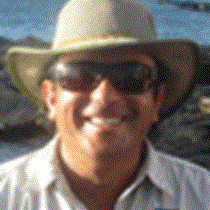Isabela & Fernandina Islands
An early announcement over National Geographic Islander’s PA system woke us up with the happy news that we were near an enormous pod of Common dolphins. The warm early morning light glanced off the sides of these marine mammals as they swam near the ship for a good half-hour, bow riding and jumping in the distance!
We were sailing the western islands of the Galápagos, and our Captain was heading to the Equator. As we drew near, we all gathered on the Bridge to look at the GPS navigational system of the National Geographic Islander scroll down to 0 degrees 00 minutes and 00 seconds. We celebrated this event with our guests as the Islander’s pirates came out to celebrate this crossing at King Neptune’s Kingdom!
Punta Vicente Roca was our first stop of the day. Here Zodiacs deployed for us to explore the coastline were we found Galápagos penguins, flightless cormorants, fur sea lions, brown noddy terns, blue-footed boobies, Pacific sunfish or Mola mola, and an endless number of the Pacific green sea turtles! After this, we prepared ourselves to go snorkeling and enjoyed close encounters with all of the animals we have previously spotted during our Zodiac ride!
Fernandina Island, the youngest and most pristine island of all, has never had invasive animals. An endless colony of marine iguanas is found here. The continuous eruptions of this volcano has produced uncounted underwater lava flows where the seaweed, the primary diet for these reptiles, grows plentifully, allowing them to graze on the shallows of this cool waters.
August is the time of the year when the female Galápagos sea lions give birth to their pups. They take advantage of the arrival of the cold Humboldt current, which drifts away from the southern tip of South America bringing all the planktonic nutrients that boosts the food chain to its most productive stage. We encountered a good number of newborn pups resting in the intertidal pools, some close to their mothers, and some others been protected by the active and careful look of the dominant bull.
Along the lava flows, a few shore birds, such as ruddy turnstones, American oystercatchers and striated herons were wandering in the tidal line, feeding on marine invertebrates.
Sunset at Fernandina was quite spectacular, and today we were delighted by a mosaic of colors in the clouds as the day came to an end.




